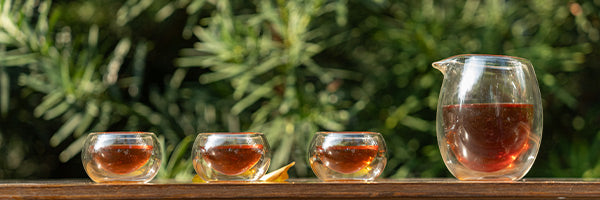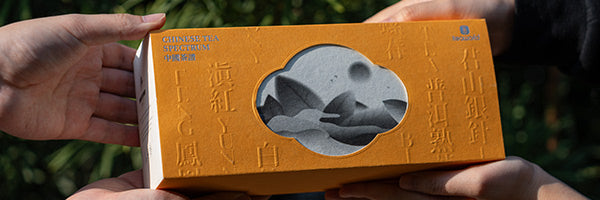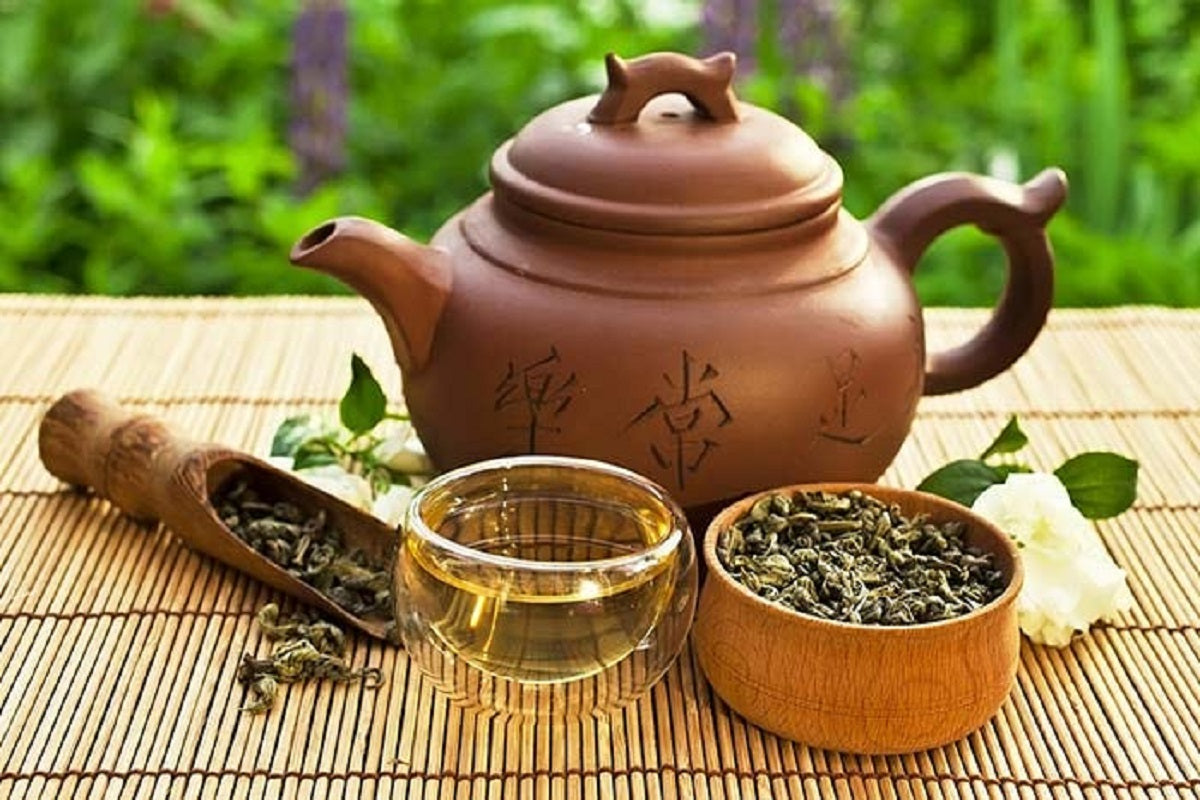I. Введение
Чай улун занимает уникальное место между черным и зеленым чаем. Его характеристики включают в себя качества как полностью окисленного черного чая, так и слабо окисленного зеленого чая, но при этом он отличается от них обоих. Особая технология обработки чая улун включает частичное окисление, что отличает его от других сортов чая. Однако многие любители и ценители чая до сих пор спорят — улун больше похож на черный или зеленый чай ?
Чтобы найти ответ на этот вопрос, мы должны изучить происхождение чая улун в Китае, изучить его специализированный процесс производства, проанализировать его состав и вкусовой профиль, сравнить его с черным и зеленым листовым чаем и исследовать его пользу для здоровья. Только рассматривая все эти факторы, мы можем по-настоящему понять истинную природу чая улун и его место среди различных классификаций листового чая . В этой статье мы раскроем сущность чая улун, сравнив его с черным и зеленым чаем.

II. Чай улун: происхождение и процесс производства
Чай улун происходит из провинции Фуцзянь в Китае. Некоторые ученые прослеживают его самые ранние производства до династии Мин в 15 веке, когда он был известен как «хуанча» или «желтый чай» из-за своего светлого цвета после окисления. Самые известные сорта по-прежнему происходят из горных регионов Фуцзянь, таких как У И Шань.
Частично окислительная ферментация — это особая технология производства, которая отличает чай улун. Чайные листья, которые еще свежие, скручиваются, завяливаются, а затем постепенно окисляются примерно до 25–70%. В отличие от этого, листовой зеленый чай окисляется только на 1–2%, чтобы полностью избежать ферментации. Это также не то же самое, что черный чай, который полностью ферментируется до уровня окисления 75–99%.
Чайные листья раскладывают тонкими слоями и дают им завянуть, снижая содержание влаги с 50–60% до 30–40% в течение 12–24 часов. Это способствует наилучшему протеканию химических реакций на последующей стадии окисления. После этого листья скручивают вручную или встряхивают в бамбуковых корзинах, чтобы разрушить клеточные стенки и способствовать ферментативному взаимодействию.
Окисление происходит в хорошо проветриваемом помещении в течение 5-10 часов. Производители умело контролируют температуру, влажность и поток воздуха, чтобы достичь желаемого уровня окисления листьев. Это придает чаю улун фирменный цвет, аромат и вкус. Наконец, листья обжигаются, чтобы завершить окисление. Улуны высшего качества могут обжигаться по отдельности.
III. Характеристики чая улун
Чай улун имеет отчетливый вкусовой профиль, который находится между зеленым и черным чаем из-за частичного окисления, которое характеризует его производство. В зависимости от сорта и стиля, заваренный лист чая улун может иметь цвет от светлого медно-оранжевого до более глубокого бордового. Как правило, он имеет цветочный, фруктовый, медовый или травянистый аромат со слабыми жареными нотками. Ценители, ищущие лучший листовой чай, часто выбирают сорта улун, которые поддерживают самые высокие стандарты качества по вкусу, аромату и обработке.
Улунский чай имеет мягкий и полусладкий вкусовой профиль в чашке. В то время как сильно окисленные сорта приобретают более солодовый, поджаренный аспект, легкие стили травянистые и цветочные. Сложность чая улун проистекает из гармонии жареных нот, напоминающих характеристики черного и зеленого чая. Его вкус полный, но не слишком резкий или резкий. Содержание кофеина находится посередине между зеленым и черным чаем.
Ключевым атрибутом, отличающим улун от других видов чая, является его уровень окисления. При 25-70% окисления его листья и настой проявляют качества как неокисленного зеленого чая, так и полностью ферментированного черного чая. Эта частичная ферментация придает улун его многогранный, но сбалансированный вкус.
IV. Сравнение улуна с черным чаем
Улун и черный чай имеют некоторые сходства, поскольку оба подвергаются контролируемому процессу окисления. На базовом уровне листовой улун и заваренные листья черного чая кажутся темнее зеленого чая. Их настой также обычно описывается как более насыщенный и немного более крепкий по вкусу.
Но есть различия, когда вы смотрите на то, насколько сильно происходит окисление. Черный чай, прошедший полную ферментацию, достигает 75–99% окисления, что придает ему более сильный, смелый вкусовой профиль с выраженными нотками патоки, дыма или вареной древесины. 25–70% окисления чая улун приводит к более мягкому послевкусию с более зелеными, цветочными нотами, которые все еще различимы среди поджаренных нот.
Также используются различные методы производства. Полная ферментация применяется к черному чаю, а затем он немедленно высушивается. Чтобы избежать полной ферментации, улун подвергается скручиванию, завяливанию и многократному окислению. Улуны с такой длительной обработкой обладают большей тонкостью, которую можно приписать только частичному окислению.
V. Сравнение чая улун с зеленым чаем
На базовом уровне улун и зеленый чай имеют китайское происхождение и минимальный уровень окисления по сравнению с черным чаем. Их заваренные листья сохраняют желто-зеленый цвет. Некоторые сорта улуна, такие как Пи Ло Чунь, могут даже приближаться к легким, растительным вкусам зеленого чая.
С другой стороны, производство и свойства значительно различаются. Перед сушкой зеленый чай окисляется лишь немного (1%–2%), чтобы остановить ферментативное потемнение. Это сохраняет его бледную окраску и зеленые, растительные вкусы нетронутыми. Перед обжигом улун подвергается более тщательному окислению на 25–70% с помощью таких методов, как скручивание и завяливание. Это добавляет поджаренные ноты, присущие улунам, которых не хватает зеленому чаю.

Зеленый чай имеет более свежий, травянистый вкус, тогда как у улуна более цветочный, полуокисленный вкус с нотками жареного солода. Зеленый чай содержит наименьшее количество кофеина, поскольку его минимальное окисление предотвращает образование кофеина. Из-за частичного окисления в улунах содержится меньше кофеина, чем в листовом черном чае, но больше, чем в зеленом чае.
VI. Польза чая улун для здоровья
Многие предполагаемые преимущества для здоровья связывают улун с его высоким содержанием полифенолов, особенно EGCG, того же антиоксидантного соединения, которым богат зеленый чай. Некоторые ключевые области исследований улуна включают:
Контроль веса: исследования показывают, что экстракт чая улун может усиливать окисление жиров и способствовать снижению веса за счет термогенеза и ингибирования всасывания жиров в кишечнике.
Здоровье сердца: Полифенолы в чае улун могут помочь снизить уровень «плохого» холестерина ЛПНП и повысить уровень «хорошего» холестерина ЛПВП. Один обзор связывает регулярное употребление чая улун со снижением риска сердечно-сосудистых заболеваний.
Противораковая активность: Исследования в пробирках и на животных показывают, что полифенолы в чае улун вызывают гибель раковых клеток и подавляют рост опухоли посредством антиоксидантных и противовоспалительных механизмов. Все еще необходимы дополнительные исследования на людях.
Защита от диабета: соединения в чае улун могут улучшить чувствительность к инсулину, защитить клетки поджелудочной железы и подавить активность ферментов, гидролизующих углеводы, поддерживая здоровый уровень сахара в крови.
Здоровье костей: Чай улун содержит минералы, такие как марганец, которые способствуют формированию костей. Одно исследование показало, что экстракт чая улун помог увеличить плотность минералов костей у крыс.
Однако, более серьезные клинические испытания все еще необходимы, прежде чем делать окончательные заявления о пользе для здоровья. Различия в выборе типа чая улун и времени заваривания также могут влиять на его биодоступность и степень пользы.
VII. Сравнение популярных сортов чая улун
В широкой категории чая улун, различные регионы и методы производства привели к появлению отличительных стилей. Давайте рассмотрим некоторые лучшие сорта улуна:
Тегуаньинь: этот сорт, считающийся «Королем улунов», возник на Тайване, но его происхождение восходит к знаменитой горе Уи в провинции Фуцзянь. Среднее окисление придает сладкие ароматы орхидеи, зерна и меда. Его нежные цветочные ароматы прекрасно сочетаются с димсамами.
Да Хун Пао: один из «четырех великих улунов» Китая из провинции Фуцзянь, обладающий богатым, сложным вкусом благодаря более длительному окислению.
Jin Xuan: более легкий стиль молочного улуна, ценимый за его сливочный вкус и длительное сладкое послевкусие. Родом из Тайваня и Китая, его мягкие травянистые и ореховые вкусы позволяют легко наслаждаться им в любое время.
Baozhong: Известный как "Pouchong", этот китайский сорт подвергается интенсивному окислению для получения более глубокого медного цвета. Дымные ноты дополняют его солодовую, похожую на клен основу. Отлично подходит также для холодного чая!
Пи Ло Чунь: Почитаемый как «Зеленый источник улитки», он озаряет душу. Этот нежно-зеленый тайваньский улун очаровывает цветочными ароматами и мягким растительным глотком.
VIII. Заваривание и подача чая улун
Правильное заваривание имеет решающее значение для полного раскрытия сложного вкусового профиля чая улун. Хотя рекомендации дают отправную точку, существует некоторая гибкость в соответствии с личным вкусом и конкретным сортом чая. Экспериментирование позволяет различить тонкие различия между сортами и стилями обработки.
Использование чайника гайвань или исин, специально предназначенного для чая улун, погружение листьев в воду помогает контролировать время заваривания вплоть до секунды. Это позволяет регулировать уровни окисления, извлекаемые из каждого настоя. Часто достаточно двух-трех заварок, прежде чем листья истощатся, хотя некоторые высококачественные цельнолистовые сорта дают четыре или более освежающих раундов, демонстрируя их глубину.
Игра с температурой воды на несколько градусов выше или ниже общего стандарта также влияет на результаты. Нагретая вода, реагирующая с ферментами листьев, вытягивает различные аспекты - например, более низкое тепло сохраняет растительные аспекты, в то время как более высокое вытягивает дополнительные жареные измерения. Замачивание короче или дольше рекомендуемого времени также производит собственные наборы эффектов.
Записи во время этих практических занятий помогают определить любимые цвета лица. Запись таких деталей, как сорт, количество листьев, соотношение воды, температура, продолжительность заваривания и дегустационные наблюдения, создает основу для последовательного воссоздания предпочитаемых заварок. Это индивидуальное понимание выводит оценку чая на новые вершины, где человек действительно понимает, как тонкости обработки проявляются в каждой удивительной чашке.
IX. Радости раннего праздника «Черная пятница» от iTeaworld
Приготовьтесь начать праздничный шопинг с ранними предложениями Black Friday от iTeaworld! С невероятными скидками и заманчивыми предложениями, нет лучшего времени, чтобы побаловать себя миром чая. Вот два лучших предложения, которые вы не захотите пропустить:
Лучший подарок: дегустатор чая
Ищете идеальный подарок для любителя чая в своей жизни? Не ищите дальше, чем предложение Tea Sampler от iTeaworld. При покупке любого из трех указанных продуктов — New Oolong Tea Sampler , Cold Brew Tea Selection или Green Tea Selection — вы получите еще один Tea Selection по вашему выбору бесплатно! Да, вы правильно прочитали — купите один, получите второй бесплатно. Просто используйте код «BF50» при оформлении заказа, чтобы воспользоваться этим фантастическим предложением. Это идеальная возможность изучить различные виды чая или удивить друга восхитительным подарочным набором для чая. Не упустите этот шанс улучшить свои впечатления от чая!
СКИДКА 20% на весь чай
Распространите тепло и радость чая в этот праздничный сезон с эксклюзивной скидкой 20% от iTeaworld. Используйте код «BF20» при оформлении заказа, чтобы получить скидку 20% на все виды чая, включая популярные сорта чая Black Friday. Это прекрасная возможность запастись любимыми сортами чая или открыть для себя новые. Если вы ищете согревающую чашку черного чая, освежающий зеленый чай или успокаивающий травяной настой, iTeaworld вам поможет. С приближением Рождества нет лучшего времени, чтобы удивить своих близких подарком в виде чая. Порадуйте их уникальными вкусами и ароматами предложений на черный чай Black Friday, которые сделают их праздничный сезон по-настоящему особенным.
Не пропустите эти потрясающие ранние предложения Черной пятницы от iTeaworld. Побалуйте себя или своих близких прекрасным миром чая и поднимите свои впечатления от чаепития на новый уровень. Спешите воспользоваться этими ограниченными по времени предложениями, пока они не закончились. Приятного чаепития и удачных покупок!
X. Заключение
Подводя итог, чай улун занимает уникальную золотую середину между зеленым и черным чаем. Его происхождение прослеживается в Китае, где был разработан специализированный процесс завяливания и окисления для частичной ферментации листьев. Это придает чаям улун их фирменные вкусы, уравновешивающие отборные растительные ноты зеленого чая с обжаренной сложностью.
Хотя улун имеет некоторые общие черты с зеленым и черным чаем, например, происхождением из Китая или прохождением окисления, он отличается промежуточным уровнем окисления 25-70%. Это придает улунам разнообразный вкусовой профиль, находящийся между слегка окисленным зеленым чаем и крепким полностью ферментированным черным чаем . Правильные методы заваривания еще больше подчеркивают эти определяющие характеристики.
В дальнейшем все еще необходимо провести больше исследований на людях, чтобы подтвердить предполагаемые преимущества чая улун для здоровья. Однако содержание в нем полифенолов указывает на его противоожирение, кардиопротекторные, противораковые и другие преимущества. В конечном счете, чай улун следует признать особой категорией, которую он культивирует — не зеленый и не черный чай, а объединяющий качества обоих только посредством искусной обработки.














































































